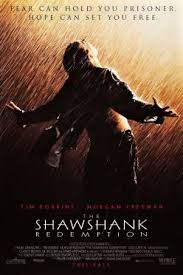In 1947, in Portland, Maine, a banker named Andy Dufresne (Tim Robbins) enters Shawshank State Prison to serve two life sentences for the murders of his wife and her lover, which he did not commit. He makes friends with “Red” Herring (Morgan Freeman), a smuggler serving a life sentence who manages to get his friend a rock hammer and a poster of Rita Hayworth. Working in the prison library, Andy is often raped by “The Sisters” gang, led by Bogs Diamond (Mark Rolston).
In 1949, Andy hears the captain of the guards, Byron Hadley (Clancy Brown) complaining about being taxed on an inheritance, and he offers to help him shelter the money legally. After the Sisters beat Andy Severely, Hadley cripples Bogs and the latter is transferred to a minimum-security hospital. Andy is not attacked again. Warden Samuel Morton (Bob Gunton) assigns Andy to the prison library, presumably to help elderly inmate Brooks Hatten (James Whitmore), but actually to facilitate Andy’s work arranging financing for the Warden and prison staff. He also writes letters to the Governor to request funding for the library.
Brooks is paroled in 1954 after a 50-year sentence but can’t live in the outside world and commits suicide. The State Legislature sends the library a donation that includes a recording of The Marriage of Figaro. Andy plays some of it over the public address system and is sent to solitary. After his release, he explains to Red that hope is what gets him through his sentence. In 1963, Norton begins to extort prison labor, profiting from public works and bribery. Andy launders the money using a fake name: Randall Stevens.
In 1965, Andy and Red befriend a young burglar named Tommy Williams (Gil Bellows). Andy helps him pass his General Educational Development exam and Tommy reveals that his cellmate in another prison confessed to the crimes for which Andy was found guilty. Andy informs Warden Norton, but he refuses to act. Norton has Hadley kill Tommy and sends Andy to solitary. Norton threatens to destroy the library, strip Andy of guard protection, and transfer him to worse conditions unless he continues to help the warden with his scam.
Andy is not released from Solitary for two months. He tells Red that he dreams of living in a Mexican town called Zihuatanejo. He asks Red to promise, when he is released, to go to a hayfield near Buxton to get a package Andy buried there. Andy asks a fellow inmate for a rope and Red fears that he is suicidal.
Next roll call, Andy’s cell is empty. Behind the poster of Raquel Welch on the wall is a tunnel that Andy had dug over the course of 19 years. He escaped with a ledger containing evidence of the Warden’s money laundering and corruption, plus he has the Warden’s clothes and poses as him to withdraw $330,000 from various banks. He mails the ledger to a local newspaper. State Police arrive to arrest the Warden, who commits suicide. The next year, Red is paroled but struggles to survive outside. But he visits Buxton and finds a cache of money and a letter inviting him to Zihuatanejo. Red finds him there on the beach.
The film was written and directed by Frank Darabout based on the 1982 Stephen King novella called Rita Hayworth and the Shawshank Redemption. It took five years to get the film made. Tom Hanks, Tom Cruise, and Kevin Costner all tried out for the part of Andy. It was released to critical acclaim but box-office disappointment. It came out at the same time as Pulp Fiction and Forrest Gump.
The film was said to be grounded in Christian mysticism, and one scene appears to mirror the Last Supper. There are numerous other biblical references in the dialogue. The evil Warden is said to be modelled on Richard Nixon. Zihuataneho is said to be heaven. There is a great deal of supposed symbolism but none of that can compete with the simple greatness of the writing and acting.
Frank Darabout’s first collaboration with Stephen King was on a short film adaptation on a story in King’s 1978 Night Shift. King did not actually see how his Shawshank story could be made into a film. Castle Rock Entertainment producer Liz Glotzer threatened to quit if Castle Rock did not produce the film, so the studio found 25 million dollars to make it. The Ohio State Reformatory in Mansfield, Ohio, was used for shooting because of its Gothic style and the fact that it had been closed for three years.
The film was nominated for seven Oscars, the most for a Stephen King adaptation. Later, Darabout adapted and directed The Green Mile and The Mist. It was the top video rental of 1995. The prison it was filmed in was supposed to be torn down but became a tourist attraction. Rotten Tomatoes gave the movie an 89% approval, and it is on Roger Ebert’s list of great movies and Number 22 on the Writer’s Guild list of 101 Great Screenplays. The Library of Congress selected it for preservation in the National Film Registry. Nelson Mandela, who knew a thing or two about prison, loved the film.

